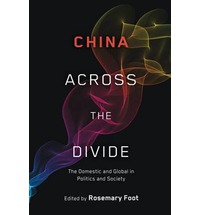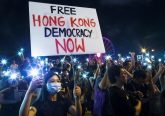 I recently interviewed Professor Rosemary Foot about her new book, China Across the Divide: the domestic and global in politics and society (New York: Oxford University Press, 2013), as part of Politics and Spires’s OxOn China series.
I recently interviewed Professor Rosemary Foot about her new book, China Across the Divide: the domestic and global in politics and society (New York: Oxford University Press, 2013), as part of Politics and Spires’s OxOn China series.
NH: What is the book about?
RF: The book’s main argument is that, as students of international relations, we need to do more to collapse the divide between the domestic and global spheres of analysis. I make this argument with special reference to China, but I think it can be applied to other countries. I have chosen three main approaches to illustrate this phenomenon of the interconnectedness between the global and domestic levels of analysis. The first section of the book looks at ideas emerging from within China itself, at both mass and elite levels, about the country’s place in the world and how it should conduct its external relations. The argument is not that these ideas determine policy decisions, but help to shape, or set the broad contours of, the decisions that are arrived at. The second section looks at involvement in inter-societal enmeshments between China and other countries, and both the intended and unintended consequences of these linkages. This part of the book looks at the ways in which these non-state relations are transforming not only China itself but also the world of which it is a part. The third section focuses on three major global issues that are salient or intrusive at the domestic level and which require either some alterations in domestic ways of life or generate resistance at the domestic level to that intrusiveness.
NH: What inspired you to write/edit it?
RF: The inspiration for the book came from a number of different sources. First, the idea came directly out of the book that I co-authored with Andrew Walter, China, the United States and Global Order, published in 2011. One of our central findings in that book was that we could understand a great deal about China’s (and America’s) levels of behavioural consistency with global order norms by focussing on the domestic saliency of the global norm in question, and then the extent to which domestic norms aligned with those at the global level. This finding reinforced my long-standing belief in the importance of the domestic level of analysis in the study of International Relations. In addition, I had often been struck, in listening to my colleagues in China studies here at Oxford and elsewhere, at how important international linkages were to understanding what were ostensibly policies that we would label “domestic”. I think it important to try to break down the divide between those who work on domestic China and those who concentrate on its external relations.
NH: Why do you think it is significant? What does it add to its field of scholarship?
RF: As I have emphasized already, the book is significant in the way it highlights the interpenetrated nature of the domestic and international spheres. It also shows the value of an interdisciplinary approach where a clearly defined theme forms a unifying analytical thread. One of the most significant aspects for me is its demonstration of some of the unintended consequences of the policies that China arrives at — often as a result of China’s large demographic footprint, one that grows ever larger as it has become more powerful.
NH: The book demonstrates a myriad of new influential actors and the resurgence and emergence of ideas (old and new) in China –complicating the control the CCP has traditionally had over its foreign and domestic policy—as well as a sense that China is nearing a cross-roads in formulating its international identity (from a developing to developed state). In understanding how these changes have come about, how significant and transformative was the period of reform and opening up?
RF: Although we can always find continuities with the pre-reform era – that is, the period before the late 1970s — I would argue that reform and opening – and especially the economic consequences of those policies — are crucial to many of the elements discussed in the book. To give just three examples: in the ideas section, we see the ways in which citizen intellectuals, scholars, and the mass public have used the larger post-reform discursive space to add their voices to the debate about China and the world. Second, China’s consumer choices have changed dramatically since reform. Chinese now have far greater autonomy and opportunity to exercise their consumer choices with inevitable, if sometimes, unintended consequences for global supply chains and for resource management. A third example relates to international diplomacy. In the area of climate change, for example, after 1993 China moved from being an oil exporter to an oil importer. Its concerns about energy security have noticeably risen and it has come to relate its desire to achieve greater energy efficiency with its climate change diplomacy at the international level. This has given new interest groups increased power to shape policy.
NH: What do you think will be the most shocking –and informative– revelation in this book for a non-China specialist?
RF: Some of the most striking examples and less well-understood aspects are contained in the section on transnationalism. The chapter on extreme markets covers the alarming matters of trade in organs, the markets for babies and wives, and the depletion of rare species. All of these are an unintended consequence of China’s greater openness to markets and its emergence as a consumer culture in which consumer desires are often satisfied through transnational linkages. Another topic that may surprise the non-specialist reader is the chapter that deals with China as an immigrant society. We tend to think of China as a country of origin of migrants. We need now to think of it as a country of destination of international migrants as well.
NH: The book offers a diverse set of viewpoints on important social, political and economic change underway in China as well as the interconnectedness that drives its international behaviour –but are there any areas that future research in this area should cover, perhaps the role of the Chinese media?
RF: Certainly the role of the international and domestic media is important in the creation of ideas about China’s role and status in world politics. In addition, there are many elements of transnationalism that could have been explored – such as the role of business networks and the transmission of business cultures into and out of China. Global issues that are intrusive at the domestic level go well beyond the three topics areas that are covered in the final section of the book. There are lots of new areas to explore.
NH: How unique or exceptional, in your opinion, is the interconnectedness underpinning China’s international behaviour? Is this interconnectedness prevalent in driving the international behaviour of other emerging powers like Brazil and India?
RF: I think it is not so exceptional. It is an analytical approach that applies more generally. However, it is a topic of particular interest in reference to the emerging powers. As a result of their emergence, these countries are reshaping many aspects of international life in a way that is mostly less true of other polities. At the same time, they remain determined to sustain their positive development trajectories, and to concentrate on managing the dramatic social and economic changes that their peoples are experiencing.








No Comment